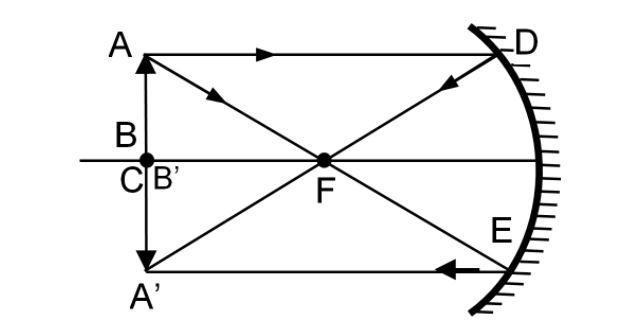
To form the image on the object itself, how should we place the object in front of a concave mirror? Explain with a ray diagram.
Answer
216.6k+ views
Hint The concave mirror which is also known as the converging mirror, because it has a reflecting surface that is depressed inside that is the concave mirror is depressed inside away from the incident light. Concave mirrors contemplate light rays inside to one focal point.
Complete step by step solution
When the object is placed at the 2F point that is the second focal point, the image will also be formed at the 2F point that is the second focal point on the other side of the lens. In this case, that is the concave mirror the image will be inverted (that is a right side up object results in an upside-down image). The image dimensions are equal to the object dimensions. A six-foot tall person would have an image that is six feet tall; the absolute value of the magnification is exactly 1. Finally, the image is a real image. Light rays actually converge at the image location. As such, the image of the object could be projected upon a sheet of paper.

Therefore, since the object should be placed at 2F to obtain the image on the object itself.
Note Convex Mirror is a curved mirror where the reflective surface bulges out towards the light source. This bulging out surface reflects light outwards and is not used to focus light. The concave mirrors are used to focus light.
Complete step by step solution
When the object is placed at the 2F point that is the second focal point, the image will also be formed at the 2F point that is the second focal point on the other side of the lens. In this case, that is the concave mirror the image will be inverted (that is a right side up object results in an upside-down image). The image dimensions are equal to the object dimensions. A six-foot tall person would have an image that is six feet tall; the absolute value of the magnification is exactly 1. Finally, the image is a real image. Light rays actually converge at the image location. As such, the image of the object could be projected upon a sheet of paper.

Therefore, since the object should be placed at 2F to obtain the image on the object itself.
Note Convex Mirror is a curved mirror where the reflective surface bulges out towards the light source. This bulging out surface reflects light outwards and is not used to focus light. The concave mirrors are used to focus light.
Recently Updated Pages
Wheatstone Bridge Explained: Working, Formula & Uses

Young’s Double Slit Experiment Derivation Explained

JEE Atomic Structure and Chemical Bonding important Concepts and Tips

JEE Amino Acids and Peptides Important Concepts and Tips for Exam Preparation

Electricity and Magnetism Explained: Key Concepts & Applications

Chemical Properties of Hydrogen - Important Concepts for JEE Exam Preparation

Trending doubts
JEE Main 2026: Application Form Open, Exam Dates, Syllabus, Eligibility & Question Papers

Derivation of Equation of Trajectory Explained for Students

Hybridisation in Chemistry – Concept, Types & Applications

Understanding the Angle of Deviation in a Prism

Understanding Collisions: Types and Examples for Students

How to Convert a Galvanometer into an Ammeter or Voltmeter

Other Pages
JEE Advanced Marks vs Ranks 2025: Understanding Category-wise Qualifying Marks and Previous Year Cut-offs

Understanding Atomic Structure for Beginners

Ideal and Non-Ideal Solutions Explained for Class 12 Chemistry

Degree of Dissociation: Meaning, Formula, Calculation & Uses

Understanding Electromagnetic Waves and Their Importance

Understanding the Electric Field of a Uniformly Charged Ring




